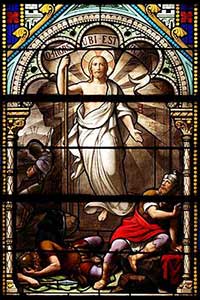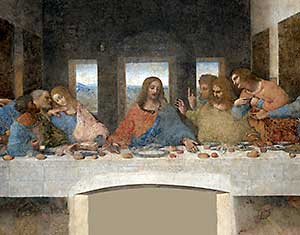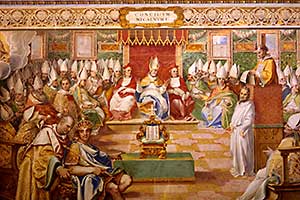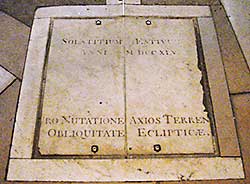Why Does the Date of Easter Keep Changing?

Easter will be celebrated on Sunday, April 4, this year. Last year, however, it was on April 12. Why can’t it just stay put like Christmas and other normal holidays?
Why the Date Changes. Western churches celebrate Easter on the first Sunday following the first Full Moon after the Vernal Equinox (first day of Spring).1 Figuring all that out is as complicated as it sounds.
The fact that phases of the Moon are involved itself makes the date of Easter change from year to year. We see a full moon every 29½ days. Since this period is slightly less than the typical 30 or 31-day month,2 the date of the full moon changes from month to month. For example, this year Boston has full moons on March 28 and April 26.
This monthly shift adds up to about 11 days per year, so that in Boston there was a full moon on April 7, 2020. In 2021, the moon will be full approximately 11 days earlier on March 28.3
Then there is the complicating factor that Easter is tied to the date of the first full moon after the Vernal Equinox, which for these purposes is March 21. Easter 2021 falls on April 4 because that is the first Sunday following the first full moon (March 28) of Spring (after March 21).
Putting all this together, Easter can fall on any Sunday from March 22 to April 25.5
Why the Calculation Is So Complicated. Easter commemorates the resurrection of Jesus Christ, just as Christmas celebrates his birth. Nothing suggests that the actual date of one event is better known than the other. Yet Christmas dependably comes on December 25 every year, while the date of Easter changes with the phases of the Moon. Why did early Christians choose such a complicated system for one holiday while sticking with a simple calendar date for the other?
The answer depends on which calendar you look at. The Bible says Jesus was crucified at the beginning of the Jewish holiday of Passover. Passover begins on the 15th day of the Jewish month of Nisan. Since the Jewish calendar is based on lunar cycles, the date of Passover on our calendar changes from year to year just like that of Easter. Thus, the time of Easter is consistent from year to year on a lunar-based calendar.
Why early Christians considered the connection between the dates of Easter and Passover to be so important is a question for historians and theologians, but there actually are many other holidays that are not observed on the dates of the events they commemorate. Presidents’ Day, for example, originally was tied to George Washington’s birthday, February 22. Today, however, Federal law puts it on the third Monday in February. When Memorial Day was first celebrated after the Civil War, pains were taken to ensure that its observance did not coincide with the date of any major battle to make it clear that the holiday was intended to honor equally all who had fallen.

It’s important to remember that the early Christians who devised this system had not grown up celebrating Christmas and Easter, their traditional holidays were Jewish, Roman, and those of the other faiths practiced in the province of Judea. Their practice makes it clear that they considered the connection between the dates of Easter and Passover to be important, even if we don’t know exactly why. It may be that at a time when Christians were persecuted in many places and had to practice their faith in secret, they may have felt safer gathering for their holiday at the same time that Jewish people were celebrating Passover.
How the Full Moon Became a Factor. You might rightly wonder what any of this has to do with the full moon and Vernal Equinox. Thus far nothing since early Christians often relied on Jewish authorities to determine the date of Passover, and thereby Easter.
As the religions drifted apart, however, some Christians complained about inaccuracies in the Jewish calculations, and wanted to be able to determine the date of Easter without reliance on Jewish authorities or the date of Passover. The full moon and Vernal Equinox provided a way to do that.
Passover begins on the 15th day of the Jewish month of Nisan. The moon is always full on that day since Jewish months begin with a New Moon, and the 15th day is halfway through the monthly lunar cycle. Thus, tying Easter to the full moon puts it at the correct time in the lunar month without explicit reference to the Jewish calendar.
Importance of the First Day of Spring. Tying the date of Easter to the first full moon after the Vernal Equinox keeps it a Spring holiday. Remember, the lunar cycle is 29½ days, so a year of 12 lunar months is only 354 days. To keep the months in line with the seasons, the Jewish calendar adds a thirteenth month every few years.
Tying the full moon to the first day of Spring achieves the same result for Easter, again without explicit reference to the Jewish calendar.

Why Easter Is Always on Sunday. It wasn’t always. Passover can begin on any day of the week and some early Christians did the same for Easter. Their practice even had a name, Quatrodecimanism, which means 14th day.
Others wanted to honor the Biblical account that the crucifixion took place on a Friday and the resurrection two days later on a Sunday. So they made Good Friday a Friday holiday and celebrated Easter the following Sunday. All Christian churches eventually adopted this practice.
Why the Dates of Church and Astronomical Events Are Sometimes Different. The exact astronomical times for the beginning of Spring and phases of the Moon vary by year and location. In the Northern hemisphere, for example, the Vernal Equinox can occur on March 19, 20 or 21. This variability may not be a big deal for a local congregation that can organize its observances on short notice, but it became unworkable as the Church became a global institution that had to plan and coordinate complex events well in advance.
Thus, when the First Council of Nicaea met in 325 A.D. to resolve matters regarding the date of Easter, it decreed that for Church purposes the Vernal Equinox would be fixed at March 21. That happened to be its astronomical date that year.
To achieve similar predictability for the phases of the Moon, churches treat the 14th day of the lunar month as the time of the full Moon, even though the astronomical event can deviate by as much as two days. The date is sometimes called the Ecclesiastical Full Moon.

The Importance of Getting It Right. The calendar we now use every day was developed in the sixteenth century to address concerns that Easter was not being celebrated at the proper time.
Careful observers noticed that over time the Julian calendar (devised by Julius Caesar) was falling out of step with the seasons, and the Vernal Equinox seemed to be drifting away from March 21. To correct this, Pope Gregory XIII issued an edict revising the calculation of leap years to the system we use today. Churches also were built so that sunlight would touch certain architectural lines on specified days, providing built-in celestial clocks to verify that the calendar remained in sync with the cosmos.9
* * * * *
The complexities surrounding the date of Easter remind us how so much of our world derives from long-forgotten considerations of history, religion and science, often seasoned with a dash of “that’s the way we’ve always done it.” But no matter how mysterious the choices made two millennia ago may seem to us, they undoubtedly made perfect sense to people at the time.
-----
- See, Calculating the Easter Date at timeanddate.com.
- This period is referred to as a synodic month. The actual length varies between 29.18 and 29.93 days because the orbits of the Earth and Moon are elliptical, not circular. See Wikipedia article on the Lunar Month.
- See dateandtime.com, phases of the Moon in Boston for 2020 and 2021.
- Stained glass window from the Church of Saint-Sauveur in Plancoët, France. Photo (May 1, 2017) by Wikipedia user Emeltet available on Wikimedia Commons.
- Information for this article comes from: First Council of Nicaea on Wikipedia; Ralph Orr, The Passover-Easter-Quartodeciman Controversy on the Grace Communion International web site; Calculating the Easter Date on timeanddate.com; and The Date of Easter from the U.S. Naval Observatory (archived at archive.org).
- Detail from Leonardo da Vinci’s fresco, The Last Supper (1495–98), at the Church of Holy Mary of Grace in Milan, Italy. Image from Wikimedia Commons.
- Fresco (1590) from the Sistine Chapel depicting the First Council of Nicaea. Image from Wikimedia Commons.
- Meridian marker for the Summer Solstice at the Church of Saint-Sulpice in Paris. Photo (2007) by Wikipedia user PHGCOM on Wikimedia Commons.
- For more information about meridian lines, see, Geoff Manaugh, Why Catholics Built Secret Astronomical Features Into Churches to Help Save Souls (Nov. 15, 2016) at Atlas Obscura web site.
This article originally appeared in our free semi-monthly newsletter. To receive future issues, please add your name to the subscription list.

